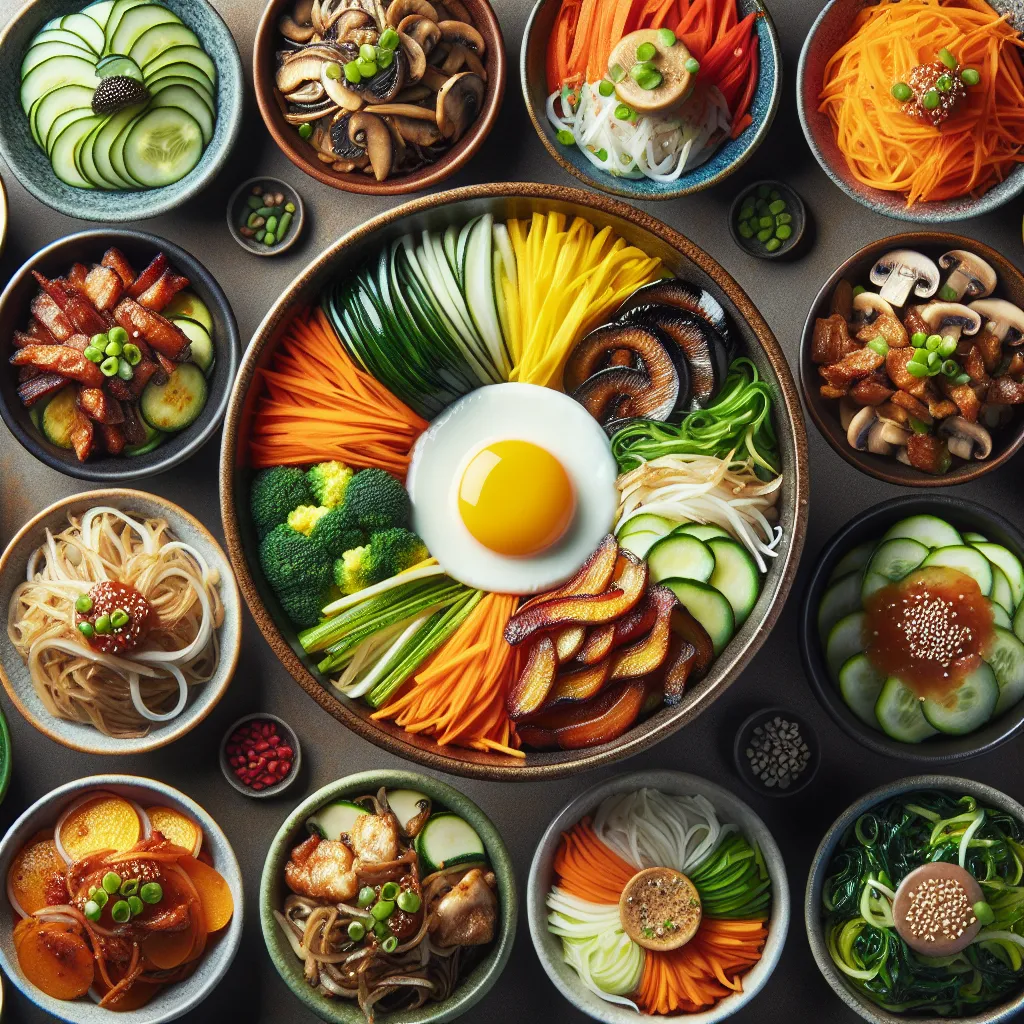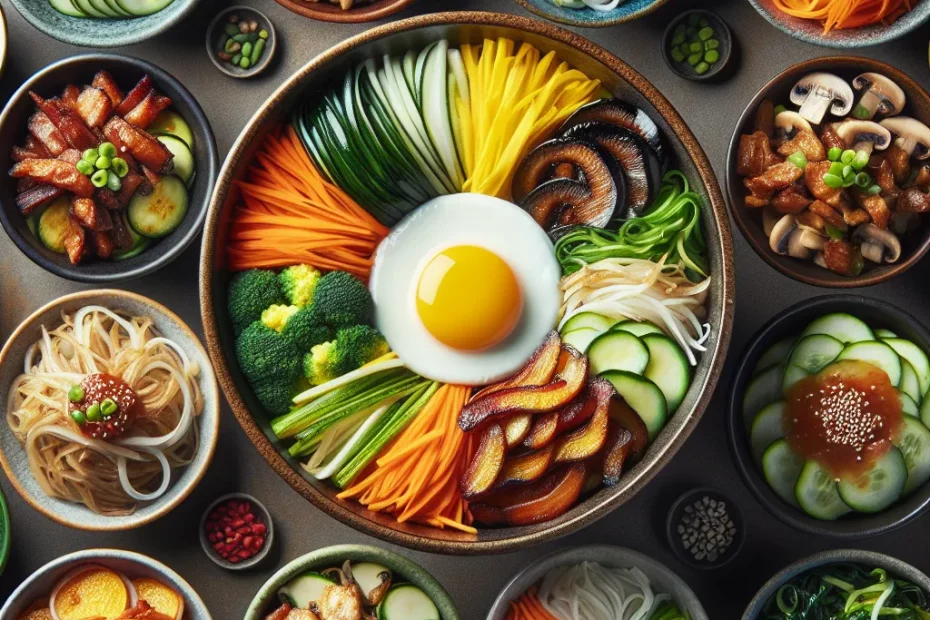Are you ready to embark on a culinary journey to discover the vibrant and flavorful world of Bibimbap? Imagine a dish that not only tantalizes your taste buds but also delights your eyes with a colorful array of ingredients. Bibimbap, a beloved Korean mixed rice bowl, is more than just a meal – it’s a celebration of harmony and balance on a plate. From its humble origins to the diverse regional variations across Korea, Bibimbap offers a glimpse into the rich tapestry of Korean cuisine. So, join me as we unravel the beauty and deliciousness of Bibimbap, one spoonful at a time!

The Origins of Bibimbap
Hey there, foodies! Today, let’s dive into the fascinating history of one of Korea’s most beloved dishes – Bibimbap! 🍲
Bibimbap, which literally translates to “mixed rice,” has been a staple in Korean cuisine for centuries. This colorful and flavorful dish is a harmonious blend of various ingredients, all coming together to create a symphony of flavors in a single bowl. 🎶
The Royal Roots
The origins of Bibimbap can be traced back to the Joseon Dynasty, where it was considered a royal dish. The king and the royal family enjoyed Bibimbap made with the finest ingredients, showcasing the culinary skills of the royal chefs. Over time, Bibimbap made its way from the royal court to the tables of commoners, becoming a popular and accessible dish for all. 👑
One of the key elements of Bibimbap is the use of fresh and seasonal ingredients. From vibrant vegetables like spinach, carrots, and mushrooms to savory proteins like beef and tofu, each component adds its own unique touch to the dish. The combination of colors, textures, and flavors is not only pleasing to the palate but also a feast for the eyes. 🥕🥬🍄
The beauty of Bibimbap lies in its versatility. While the classic Bibimbap features a fried egg on top, there are countless variations of this dish across Korea. Some regions add spicy gochujang sauce for a kick, while others incorporate seafood for a taste of the sea. Each region puts its own spin on Bibimbap, making it a dish that truly reflects the diversity of Korean cuisine. 🍳🌶️🦐
So, the next time you sit down to enjoy a steaming bowl of Bibimbap, remember the rich history and cultural significance behind this iconic dish. Let each spoonful take you on a journey through time, savoring the flavors of tradition and innovation in every bite. Bon appétit! 🇰🇷🍚
Cooking Techniques and Ingredients
Rice
Rice: The base of any Bibimbap is, of course, the rice. Traditionally, short-grain white rice is used for its sticky texture that helps hold all the ingredients together. Make sure to rinse the rice thoroughly before cooking to remove excess starch.
Protein
Protein: Bibimbap offers a variety of protein options such as bulgogi (marinated beef), spicy pork, chicken, tofu, or even a fried egg. Each protein adds its own unique flavor profile to the dish.
Vegetables
Vegetables: The beauty of Bibimbap lies in its colorful array of vegetables. Common choices include julienned carrots, spinach, mushrooms, zucchini, bean sprouts, and radish. Each vegetable is usually seasoned separately to enhance its taste.
Gochujang
Gochujang: The key to Bibimbap’s signature spicy kick is the gochujang sauce. This fermented chili paste not only adds heat but also depth of flavor to the dish. Adjust the amount based on your spice tolerance.
Mixing Technique
Mixing Technique: The most fun part of enjoying Bibimbap is mixing all the ingredients together! Start by adding a dollop of gochujang and sesame oil to the rice, then arrange the vegetables and protein on top. Mix everything thoroughly to distribute the flavors evenly.
Hot Stone Bowl
Hot Stone Bowl: For an extra special touch, serve your Bibimbap in a sizzling hot stone bowl. The heat from the bowl creates a crispy layer of rice at the bottom, adding a delightful textural contrast to the dish.
Pickled Ingredients
Pickled Ingredients: To balance out the richness of the dish, Bibimbap often includes pickled ingredients like kimchi or pickled radish. These add a tangy and refreshing element to each bite.
Garnishes
Garnishes: Finally, don’t forget the garnishes! Sprinkle some toasted sesame seeds and nori flakes on top for added flavor and visual appeal.
Now that you’ve mastered the cooking techniques and ingredients of Bibimbap, it’s time to gather your supplies and get cooking! Get ready to experience a symphony of flavors in every bite of this beloved Korean dish. Enjoy! 🌟
Variations Across Korea
Bibimbap, one of Korea’s most beloved dishes, is a colorful mixed rice bowl that showcases the beauty of Korean cuisine. As you travel across Korea, you’ll discover that bibimbap comes in various regional variations, each with its own unique twist and flavor profile. From the bustling streets of Seoul to the serene countryside of Jeonju, bibimbap reflects the diverse culinary landscape of Korea.
Seoul-style Bibimbap
In Seoul, the capital city known for its vibrant food scene, you can find bibimbap served in trendy restaurants and humble street food stalls alike. The Seoul-style bibimbap is often topped with a variety of fresh vegetables, marinated beef, and a fried egg, creating a visually appealing dish that is as delicious as it is colorful. The gochujang (Korean chili paste) mixed into the bibimbap adds a spicy kick that sets it apart from other regional variations.
Jeonju Bibimbap
On the other hand, in Jeonju, a city renowned for its traditional Korean cuisine, you’ll encounter a more authentic version of bibimbap. Jeonju bibimbap is characterized by the use of high-quality ingredients such as locally grown vegetables, top-grade beef, and fragrant sesame oil. The presentation of Jeonju bibimbap is meticulous, with each ingredient carefully arranged in a beautiful harmony of colors and textures.
Busan Bibimbap
As you venture further south to Busan, Korea’s bustling port city, you’ll find a seafood twist on the classic bibimbap. Busan bibimbap features an array of fresh seafood such as squid, shrimp, and octopus, giving the dish a briny and umami-rich flavor profile. The addition of seaweed and fish roe enhances the maritime essence of Busan bibimbap, making it a favorite among seafood lovers.
Gangwon Bibimbap
In the rural regions of Gangwon Province, bibimbap takes on a more rustic and hearty character. Gangwon bibimbap is often topped with mountain vegetables, wild mushrooms, and hearty soybean sprouts, reflecting the region’s abundant natural resources. The earthy flavors of Gangwon bibimbap provide a comforting and wholesome dining experience, perfect for those seeking a taste of traditional Korean cuisine.
Wherever you go in Korea, you’re sure to encounter a unique variation of bibimbap that reflects the local flavors and culinary traditions of the region. Whether you prefer the spicy kick of Seoul-style bibimbap or the fresh seafood twist of Busan bibimbap, there’s a version of this iconic dish to suit every palate. So, next time you find yourself in Korea, be sure to explore the diverse world of bibimbap and savor the rich tapestry of flavors that this beloved dish has to offer! 🍚🥢
Health Benefits and Nutritional Value
Hey there, foodies and health enthusiasts! Today, let’s dive into the wonderful world of Bibimbap – Korea’s colorful mixed rice bowl that not only delights your taste buds but also packs a powerful nutritional punch. Let’s uncover the secrets behind the beauty of this vibrant dish!
Nutrient-Rich Ingredients
Bibimbap is a harmonious blend of various ingredients such as rice, vegetables, meat, egg, and gochujang (Korean chili paste). Each component brings its own set of nutrients to the table, creating a balanced and wholesome meal.
Protein Power
The protein in Bibimbap comes from the meat (usually beef) and egg. Protein is essential for muscle repair, growth, and overall health. By including protein-rich ingredients, Bibimbap helps keep you full and satisfied for longer periods.
Vitamins and Minerals Galore
Loaded with an array of colorful vegetables like spinach, carrots, mushrooms, and bean sprouts, Bibimbap is a treasure trove of vitamins and minerals. These nutrients are crucial for various bodily functions, including immune support, energy production, and bone health.
Healthy Carbohydrates
The base of Bibimbap is rice, providing a good source of carbohydrates for energy. Opt for brown rice for added fiber, which aids in digestion and helps you feel full. The combination of rice and vegetables makes Bibimbap a well-rounded meal for sustained energy levels.
Spice It Up with Gochujang
Gochujang, the iconic Korean chili paste, not only adds a kick of flavor but also brings a host of health benefits. Packed with antioxidants and capsaicin, gochujang can help boost metabolism, reduce inflammation, and improve heart health.
Egg-cellent Addition
The sunny-side-up egg on top of Bibimbap not only adds a visual appeal but also contributes to the dish’s nutritional value. Eggs are a good source of high-quality protein, vitamins, and minerals, making them a nutritious choice for any meal.
In conclusion, Bibimbap is not just a feast for the eyes but also a nutritional powerhouse that offers a wide range of health benefits. So, the next time you dig into a bowl of Bibimbap, savor each bite knowing that you’re nourishing your body with a rainbow of nutrients!
There you have it – the beauty of Bibimbap unveiled, one colorful ingredient at a time! Enjoy exploring the world of Korean cuisine and reaping the health rewards it has to offer. Cheers to good food and good health!
In conclusion, Bibimbap is not just a meal, but a true representation of Korean culinary artistry. Its vibrant colors, diverse ingredients, and harmonious flavors come together to create a dish that is as visually appealing as it is delicious. Whether you’re a food enthusiast looking to explore new flavors or someone seeking a nutritious and balanced meal, Bibimbap has something to offer for everyone. So next time you have a craving for something flavorful and satisfying, consider trying out this iconic Korean mixed rice bowl. You won’t be disappointed!
